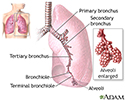Hydrocarbon pneumonia
Pneumonia - hydrocarbon
Hydrocarbon pneumonia is caused by drinking or breathing in gasoline, kerosene, furniture polish, paint thinner, or other oily materials or solvents. Many of these hydrocarbons are thin liquids. If you drank one of these hydrocarbons, it is likely some will slip down your windpipe and into your lungs (aspiration) rather than going down your food pipe (esophagus) and into your stomach. This can easily happen if you try to siphon gas out of a gas tank with a hose and your mouth.
Hydrocarbons may be inhaled intentionally for intoxication, especially by adolescents. This is referred to as “huffing.”
These products cause fairly rapid changes in the lungs, including inflammation, swelling, and bleeding.
Symptoms
Symptoms may include any of the following:
- Coma (lack of responsiveness)
- Coughing or grunting respiration
- Blue lips and fingernails (cyanosis)
- Fever
- Shortness of breath
- Smell of a hydrocarbon product on the breath
- Stupor (decreased level of alertness)
- Vomiting
- Wheezing
Exams and Tests
At the emergency room, the health care provider will check vital signs, including temperature, pulse, breathing rate, and blood pressure.
The following tests and interventions (actions taken for improvement) may be done in the emergency department:
- Arterial blood gas (acid-base balance) monitoring
- Breathing support, including oxygen, inhalation treatment, breathing tube and ventilator (breathing machine), in severe cases
- Complete blood count (CBC)
- Chest x-ray
- ECG (electrocardiogram, or heart tracing)
- Fluids by vein (intravenous or IV)
- Blood metabolic panel
- Toxicology screen
Treatment
Those with mild symptoms should be evaluated by doctors in an emergency room, but may not require a hospital stay. The minimum observation period after inhalation of a hydrocarbon is 6 hours.
People with moderate and severe symptoms are usually admitted to the hospital, occasionally to an intensive care unit (ICU).
Hospital treatment will likely include continuing some or all of the interventions started in the emergency department.
Outlook (Prognosis)
Most children who drink or inhale hydrocarbon products and develop chemical pneumonitis (lung inflammation without infection) recover fully following treatment. Highly toxic hydrocarbons may rapidly cause respiratory failure and death. Repeated ingestions or inhalations may lead to permanent brain damage (including memory, attention and judgment deficits, chronic confusion, dementia and psychiatric problems), liver damage, and other organ damage.
Possible Complications
Complications may include any of the following:
- Pleural effusion (fluid surrounding the lungs)
- Pneumothorax (collapsed lung from huffing)
- Secondary bacterial infections
When to Contact a Medical Professional
If you know or suspect that your child has swallowed or inhaled a hydrocarbon product, take them to the emergency room immediately. DO NOT use ipecac to make the person throw up.
Prevention
If you have young children, be sure to identify and carefully store materials containing hydrocarbons.
References
Kuschner WG, Blanc PD. Acute responses to toxic exposures. In: Broaddus VC, Ernst JD, King TE, et al, eds. Murray and Nadel's Textbook of Respiratory Medicine. 7th ed. Philadelphia, PA: Elsevier; 2022:chap 103.
Wang GS, Buchanan JA. Hydrocarbons. In: Walls RM, ed. Rosen's Emergency Medicine: Concepts and Clinical Practice. 10th ed. Philadelphia, PA: Elsevier; 2023:chap 147.
Review Date: 1/2/2023







